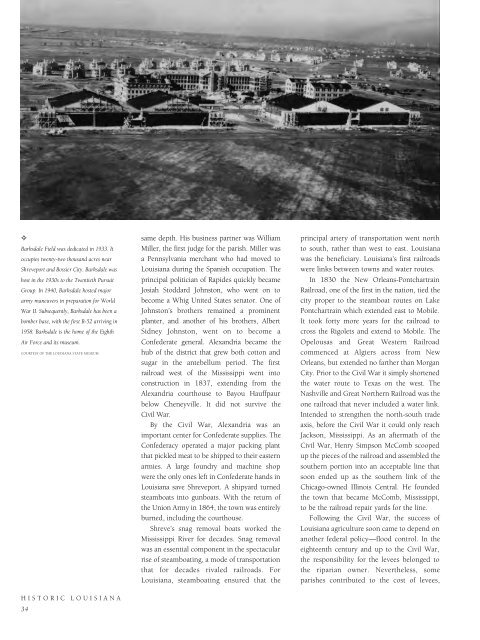Historic Louisiana
An illustrated history of Louisiana, paired with the histories of companies, families and organizations that make the state great.
An illustrated history of Louisiana, paired with the histories of companies, families and organizations that make the state great.
Create successful ePaper yourself
Turn your PDF publications into a flip-book with our unique Google optimized e-Paper software.
✧<br />
Barksdale Field was dedicated in 1933. It<br />
occupies twenty-two thousand acres near<br />
Shreveport and Bossier City. Barksdale was<br />
host in the 1930s to the Twentieth Pursuit<br />
Group. In 1940, Barksdale hosted major<br />
army maneuvers in preparation for World<br />
War II. Subsequently, Barksdale has been a<br />
bomber base, with the first B-52 arriving in<br />
1958. Barksdale is the home of the Eighth<br />
Air Force and its museum.<br />
COURTESY OF THE LOUISIANA STATE MUSEUM.<br />
HISTORIC LOUISIANA<br />
34<br />
same depth. His business partner was William<br />
Miller, the first judge for the parish. Miller was<br />
a Pennsylvania merchant who had moved to<br />
<strong>Louisiana</strong> during the Spanish occupation. The<br />
principal politician of Rapides quickly became<br />
Josiah Stoddard Johnston, who went on to<br />
become a Whig United States senator. One of<br />
Johnston’s brothers remained a prominent<br />
planter, and another of his brothers, Albert<br />
Sidney Johnston, went on to become a<br />
Confederate general. Alexandria became the<br />
hub of the district that grew both cotton and<br />
sugar in the antebellum period. The first<br />
railroad west of the Mississippi went into<br />
construction in 1837, extending from the<br />
Alexandria courthouse to Bayou Hauffpaur<br />
below Cheneyville. It did not survive the<br />
Civil War.<br />
By the Civil War, Alexandria was an<br />
important center for Confederate supplies. The<br />
Confederacy operated a major packing plant<br />
that pickled meat to be shipped to their eastern<br />
armies. A large foundry and machine shop<br />
were the only ones left in Confederate hands in<br />
<strong>Louisiana</strong> save Shreveport. A shipyard turned<br />
steamboats into gunboats. With the return of<br />
the Union Army in 1864, the town was entirely<br />
burned, including the courthouse.<br />
Shreve’s snag removal boats worked the<br />
Mississippi River for decades. Snag removal<br />
was an essential component in the spectacular<br />
rise of steamboating, a mode of transportation<br />
that for decades rivaled railroads. For<br />
<strong>Louisiana</strong>, steamboating ensured that the<br />
principal artery of transportation went north<br />
to south, rather than west to east. <strong>Louisiana</strong><br />
was the beneficiary. <strong>Louisiana</strong>’s first railroads<br />
were links between towns and water routes.<br />
In 1830 the New Orleans-Pontchartrain<br />
Railroad, one of the first in the nation, tied the<br />
city proper to the steamboat routes on Lake<br />
Pontchartrain which extended east to Mobile.<br />
It took forty more years for the railroad to<br />
cross the Rigolets and extend to Mobile. The<br />
Opelousas and Great Western Railroad<br />
commenced at Algiers across from New<br />
Orleans, but extended no farther than Morgan<br />
City. Prior to the Civil War it simply shortened<br />
the water route to Texas on the west. The<br />
Nashville and Great Northern Railroad was the<br />
one railroad that never included a water link.<br />
Intended to strengthen the north-south trade<br />
axis, before the Civil War it could only reach<br />
Jackson, Mississippi. As an aftermath of the<br />
Civil War, Henry Simpson McComb scooped<br />
up the pieces of the railroad and assembled the<br />
southern portion into an acceptable line that<br />
soon ended up as the southern link of the<br />
Chicago-owned Illinois Central. He founded<br />
the town that became McComb, Mississippi,<br />
to be the railroad repair yards for the line.<br />
Following the Civil War, the success of<br />
<strong>Louisiana</strong> agriculture soon came to depend on<br />
another federal policy—flood control. In the<br />
eighteenth century and up to the Civil War,<br />
the responsibility for the levees belonged to<br />
the riparian owner. Nevertheless, some<br />
parishes contributed to the cost of levees,
















